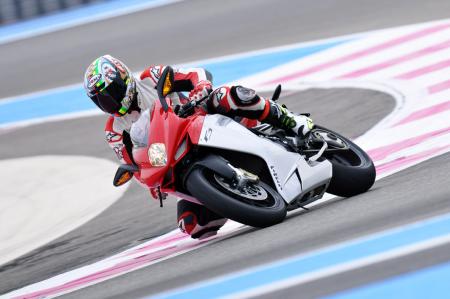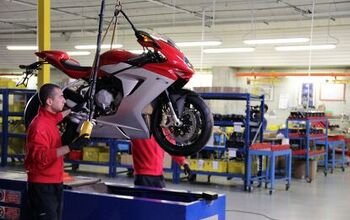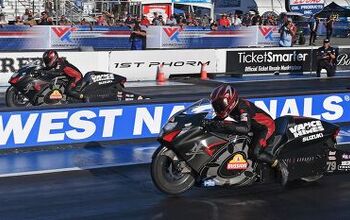2012 MV Agusta F3 675 Review - Motorcycle.com
MV Agusta’s all-new F3 675 opens up a fresh market to the elite MV Agusta lineup by entering the middleweight class. The mid-sized sportbike category includes the 600cc supersports from Japan’s Big Four, but the F3 uses the 675cc, three-cylinder formula pioneered by Triumph and its Daytona 675 instead of four-cylinder engines like the Japanese. Our Euro correspondent took it for some hot laps at the Paul Ricard circuit in the South of France.
In its segment amongst the inline-Four 600s where half a horse is considered big news, the MV Agusta F3 carries superb punch indeed. The F3 675 is claimed to deliver 126 hp at 14.400 rpm. In terms of raw technical specifications, the F3 is very close to the Triumph Daytona 675, which is the other Triple in the segment. But the F3 carries a lot more electronics from this decade, including traction control and full ride-by-wire throttle control.
Traction control on this day is good news for us test riders because just before we started our first warm up laps it was 28 degrees Fahrenheit, and that’s a record for me on a race track. The 8-level traction control works well on this cold day, and despite the fact that the lean gyros and a few other electronic aids are not activated yet, I felt confident through the slower parts of the circuit.
The chicane after the start/finish straight is taken at around 30 mph and is followed by heavy acceleration toward a beautiful but technical right-left-right where the left is banked and blind. This variation which is actually on the Mistral straight was there on this day to avoid icy patches, but I really enjoyed riding the F3 on this part of the circuit. After this it was full throttle through to fifth gear or even sixth reaching speeds of more than 150 mph. The final right out onto the Mistral straight ends in a high-speed left where I experienced lots of wheelspin the traction control handled, allowing the throttle to be pinned.
I know a bike’s appearance is subjective, but my eyes see a very beautiful motorcycle that doesn’t look remotely like anything you’d call budget. Still that’s what it is; the F3 is a budget motorcycle, Italian style. At $13,498, the F3 will be a mouth-watering prospect to anybody looking for the ultimate middleweight supersport. Its several notches above the Big Four in terms of desirability, and its real competitors are the Triumph Daytona 675 and Ducati 848. The Daytona starts at $10,999 and ranges to $12,699 for the Ohlins-equipped 675R version. The base Ducati lists higher than the MV at $13,995, but the Corse SE version (with traction-control, quick-shifter and Ohlins shock) lists for $14,995.
The F3 was thoroughly enjoyable to feed in the gears via the quick shifter from second to third and up, and the acceleration is more than satisfactory, particularly in the lower three gears. Again the sound is fantastic, and despite the fact the F3 isn’t a true racing bike, it sure does sound like one! Wheelies come easy by just using the throttle, but the final version will be available with anti-wheelie for those that are insecure about such antics or need it for racing.
The Marzocchi front suspension and the Sachs rear shock is by now a trademark MV Agusta feature, and I’m impressed with the feel of the front end when hard on the Brembo radial brakes. Thankfully, Pirelli had brought along some extra sticky tires for us in the Diablo Supercorsa. One could argue that on a circuit where the ambient temperature never reached higher than 50 degrees Fahrenheit the SC2 (medium) compound would never be warm enough to take full effect in the grip area. This may be true, but Paul Ricard’s surface is among the best money can buy. In the world of supersport tires, same goes for the Diablo Supercorsa. Combine these two and you get a combination that, despite the cold, provided plenty of grip. This didn’t stop the rear from sliding its way through certain corners, but the chassis of the F3 is so good that it’s only fun and games doing so.
There is something about an MV that makes it feel slightly heavier than it is at crawling speed. Perhaps it’s the sultry lines deceiving me into thinking there’s more mass than there actually is. Don’t get me wrong here, the F3 has almost the exact frontal dimensions as the F4 but is much lighter. Bringing it up to speed, the chassis is superbly stable and well balanced. The faster I went the more planted the F3 felt. The slight liveliness through some of the corners just added to my book of feedback and gave me confidence to push more. With its ultra compact new Triple, MV Agusta have been able to construct the chassis with a longer single-sided swingarm than previous MV models, whilst keeping a short 1380mm wheel base. All in all the F3 weighs in at 381 lbs that is easy to control.
Conclusion
The MV Agusta F3 675 Triple is a dream come true for many, and not least for the MV factory itself. MV Agusta finally has something to offer the much wider audience that are interested in a middleweight supersport. I’d say this is a motorcycle perfectly able to give extra satisfaction even for those looking for something to replace their 600s with and the perfect stepping stone on the way to that full-on literbike. Its chassis is superb and the engine very exciting without going over the top.
Despite the fact that the F3 is an all new MV model there is no real gremlins there. All that’s needed are small adjustments perhaps to the powerband and to incorporate all the electronics as promised by the Varese factory. The F3 is the definitive framework for a future perfectionist in the supersport segment.
| Highs: | Lows: | |
| Chassis and handling MV’s new 675cc triple is one to behold and it will get even better with the years Great ergonomics and packaging | Throttle response issues at slower speeds Electronic rider aids not fully sorted |
More by Tor Sagen































Comments
Join the conversation